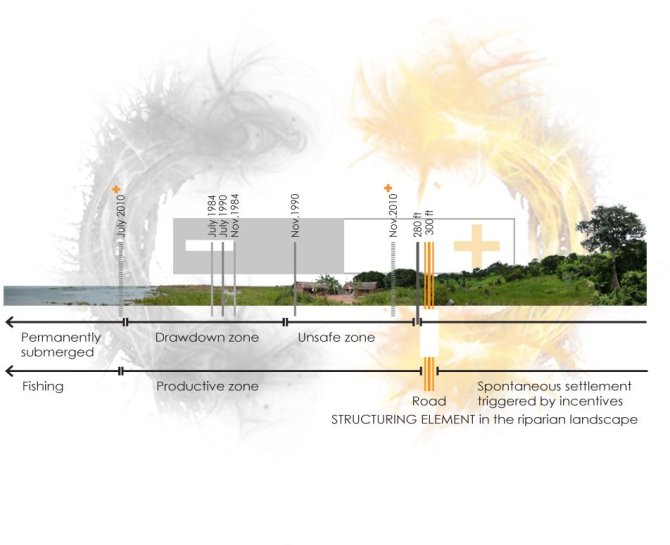Restructuring the Resettled Landscape
The artificial Volta Lake in Ghana is one of many artificial lakes in Sub-Sahara Africa, but distinctive because of its size [85.000 km2] and age [the Akosombo Dam was finished in 1964]. In the riparian landscape around the Volta Lake, informal activities and settlement is occurring on a large scale, despite planning precautions.

- Guiding Informal Activities and Settlement in the Riparian Landscape of the Volta Lake, Ghana -
Miranda Schut and Ilse Verwer
competition: Archiprix 2011, Second Prize
Posters as pdf file (4.40 MB)
Abstract
The artificial Volta Lake in Ghana is one of many artificial lakes in Sub-Sahara Africa, but distinctive because of its size [85.000 km2] and age [the Akosombo Dam was finished in 1964]. In the riparian landscape around the Volta Lake, informal activities and settlement is occurring on a large scale, despite planning precautions. The lake and the riparian landscape offer a relatively large abundance of natural resources, providing the potential for settlers to conduct multiple livelihood activities to sustain their living. However, the landscape is vulnerable, and the growing pressure is causing environmental degradation. In addition, sedimentation threatens the hydro-electric power generation. The uniform government policy appears to be an inadequate planning approach.
In this thesis, the possibilities of a integrated landscape based strategy are researched. The aim is to balance informal settlement and lakeside dwellers’ livelihood strategies with the protection of the environment to diminish sedimentation and degradation. In the design, the riparian landscape is structured using a road system, creating a framework. At strategic sites the link of infrastructural facilities to the road plays a central role in guiding the informal activities and settlement. This incentive planning approach uses limited financial resources and minimal land ownership. The positioning of social facilities provides the basic structure in this open-ended development. The design integrates several solutions tackling problems concerning problematic access, erratic and unreliable power supply, access to basic services like clean drinking water, environmental sanitation and health care and living conditions and outdoor space. The provision of basic needs will trigger concentrated development of settlement and private initiatives along the network, relieving the pressure from the most vulnerable part of the landscape, towards safe locations with a minimal risk of flooding. Food insecurity is reduced by improving water retention in the landscape, making it possible to increase agricultural production as long as the environmental system is protected from erosion, depletion and pollution.